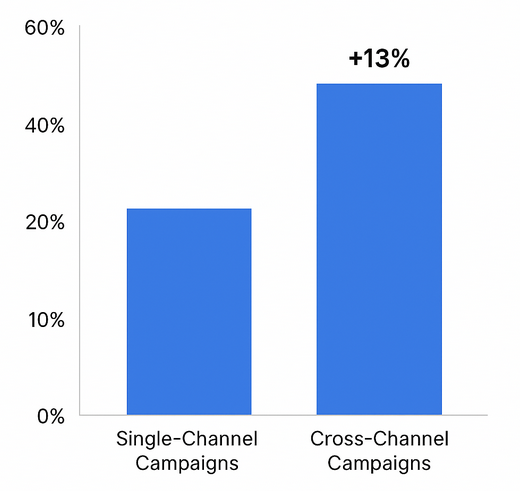This article breaks down actionable methods to align your cross-channel ad strategy for superior performance.
Running ads on a single platform can bring results, but combining Meta (Facebook and Instagram) and Google Ads unlocks a much greater opportunity. Together, these platforms cover nearly the entire digital customer journey — from discovery to purchase. When used strategically, they can amplify each other’s strengths, leading to higher engagement, lower acquisition costs, and better ad efficiency.
Why Combine Meta and Google Ads?

Brands with strong cross-channel strategies achieve up to 89% customer retention, versus much lower retention for weak strategies
1. Broader Audience Reach
Google captures active search intent, while Meta targets passive interest. According to WordStream, Google Ads reach over 90% of internet users, while Meta platforms engage more than 3 billion monthly active users. Combining both ensures you reach potential customers wherever they are in the buying journey.
2. Consistent Brand Visibility
When people see your brand in search results and then encounter it on social media, it reinforces trust and recall. This multi-touch approach strengthens brand recognition and moves users down the funnel faster.
3. Improved Conversion Performance
Studies show that businesses using both search and social ads see up to 35% higher conversion rates than those relying on one channel alone. Cross-platform data insights help optimize campaigns for better results.
How to Build a Unified Ad Strategy
1. Start with Shared Goals
Define what you want to achieve across both channels—awareness, leads, or sales. Align campaign objectives and use similar KPIs to measure success consistently.
2. Use Retargeting Across Platforms
Create retargeting audiences on Meta based on users who clicked your Google Ads but didn’t convert. Likewise, re-engage social visitors with Google Display or YouTube campaigns. This ensures no lead is lost between platforms.
3. Sync Messaging and Visuals
Your ad creatives should tell a coherent story across platforms. Maintain consistent branding, color schemes, and tone while tailoring the message to each platform’s audience mindset.
4. Leverage Data from Both Platforms
Cross-analyze metrics such as click-through rate (CTR), cost per lead (CPL), and conversion rate (CVR). Use Google Ads to understand intent-based keywords and Meta to uncover audience interests and behaviors.
5. Optimize Budget Allocation Dynamically
Use data-driven insights to move budgets where performance is strongest. For example, if Google Ads show strong bottom-funnel conversions, increase investment there, while keeping Meta focused on top-funnel engagement.
Key Performance Insights

Cross-channel campaigns deliver ~13% higher ROAS than single-channel campaigns
-
Users exposed to both Google Search and Meta Ads are 70% more likely to convert than those exposed to only one channel (Data-driven marketing report, 2024).
-
Cross-channel remarketing reduces average cost per acquisition (CPA) by up to 25%.
-
Integrated campaigns improve ad recall by 2.5x compared to single-channel campaigns.
Common Mistakes to Avoid
-
Running campaigns in isolation without sharing insights between teams.
-
Using identical creatives across platforms without adapting to audience behavior.
-
Ignoring retargeting opportunities across channels.
Final Thoughts
Combining Meta and Google Ads is not about doubling your spend; it’s about amplifying efficiency. By uniting intent-based and interest-based advertising, you can build a holistic funnel that drives awareness, engagement, and conversions more effectively than either platform alone.
You may also like:

